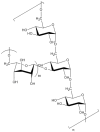Bacterial extracellular polysaccharides involved in biofilm formation
- PMID: 19633622
- PMCID: PMC6254922
- DOI: 10.3390/molecules14072535
Bacterial extracellular polysaccharides involved in biofilm formation
Abstract
Extracellular polymeric substances (EPS) produced by microorganisms are a complex mixture of biopolymers primarily consisting of polysaccharides, as well as proteins, nucleic acids, lipids and humic substances. EPS make up the intercellular space of microbial aggregates and form the structure and architecture of the biofilm matrix. The key functions of EPS comprise the mediation of the initial attachment of cells to different substrata and protection against environmental stress and dehydration. The aim of this review is to present a summary of the current status of the research into the role of EPS in bacterial attachment followed by biofilm formation. The latter has a profound impact on an array of biomedical, biotechnology and industrial fields including pharmaceutical and surgical applications, food engineering, bioremediation and biohydrometallurgy. The diverse structural variations of EPS produced by bacteria of different taxonomic lineages, together with examples of biotechnological applications, are discussed. Finally, a range of novel techniques that can be used in studies involving biofilm-specific polysaccharides is discussed.
Figures









Similar articles
-
Rediscovering bacterial exopolysaccharides of terrestrial and marine origins: novel insights on their distribution, biosynthesis, biotechnological production, and future perspectives.Crit Rev Biotechnol. 2022 Jun;42(4):597-617. doi: 10.1080/07388551.2021.1942779. Epub 2021 Jul 29. Crit Rev Biotechnol. 2022. PMID: 34320886 Review.
-
Investigation of extracellular polymeric substances (EPS) properties of P. aeruginosa and B. subtilis and their role in bacterial adhesion.Colloids Surf B Biointerfaces. 2016 Oct 1;146:459-67. doi: 10.1016/j.colsurfb.2016.06.039. Epub 2016 Jun 23. Colloids Surf B Biointerfaces. 2016. PMID: 27395039
-
Effects of hydrodynamic conditions on the composition, spatiotemporal distribution of different extracellular polymeric substances and the architecture of biofilms.Chemosphere. 2022 Nov;307(Pt 4):135965. doi: 10.1016/j.chemosphere.2022.135965. Epub 2022 Aug 10. Chemosphere. 2022. PMID: 35963380
-
Distinct roles of extracellular polymeric substances in Pseudomonas aeruginosa biofilm development.Environ Microbiol. 2011 Jul;13(7):1705-17. doi: 10.1111/j.1462-2920.2011.02503.x. Epub 2011 May 23. Environ Microbiol. 2011. PMID: 21605307
-
Bacterial extracellular vesicles: Modulation of biofilm and virulence properties.Acta Biomater. 2024 Apr 1;178:13-23. doi: 10.1016/j.actbio.2024.02.029. Epub 2024 Feb 27. Acta Biomater. 2024. PMID: 38417645 Review.
Cited by
-
The Anti-Biofilm Properties of Phloretin and Its Analogs against Porphyromonas gingivalis and Its Complex Flora.Foods. 2024 Jun 24;13(13):1994. doi: 10.3390/foods13131994. Foods. 2024. PMID: 38998500 Free PMC article.
-
Antibacterial fatty acids destabilize hydrophobic and multicellular aggregates of biofilm in S. aureus.J Antibiot (Tokyo). 2017 Feb;70(2):115-121. doi: 10.1038/ja.2016.76. Epub 2016 Jun 29. J Antibiot (Tokyo). 2017. PMID: 27353168
-
Exopolysaccharide Carbohydrate Structure and Biofilm Formation by Rhizobium leguminosarum bv. trifolii Strains Inhabiting Nodules of Trifoliumrepens Growing on an Old Zn-Pb-Cd-Polluted Waste Heap Area.Int J Mol Sci. 2021 Mar 10;22(6):2808. doi: 10.3390/ijms22062808. Int J Mol Sci. 2021. PMID: 33802057 Free PMC article.
-
Photodynamic inactivation of biofilm: taking a lightly colored approach to stubborn infection.Expert Rev Anti Infect Ther. 2013 Jul;11(7):669-93. doi: 10.1586/14787210.2013.811861. Expert Rev Anti Infect Ther. 2013. PMID: 23879608 Free PMC article. Review.
-
Effects of Sub-Minimum Inhibitory Concentrations of Imipenem and Colistin on Expression of Biofilm-Specific Antibiotic Resistance and Virulence Genes in Acinetobacter baumannii Sequence Type 1894.Int J Mol Sci. 2022 Oct 21;23(20):12705. doi: 10.3390/ijms232012705. Int J Mol Sci. 2022. PMID: 36293559 Free PMC article.
References
Publication types
MeSH terms
Substances
LinkOut - more resources
Full Text Sources
Other Literature Sources

